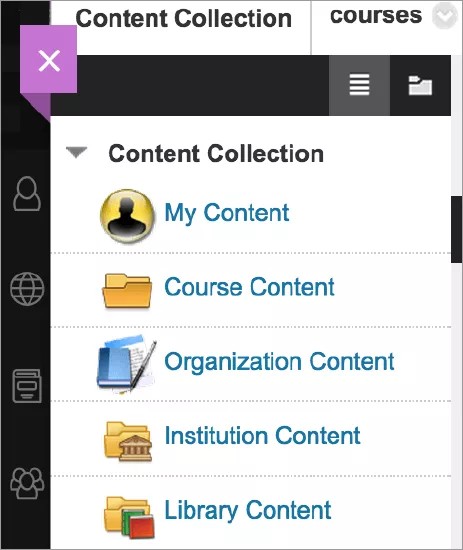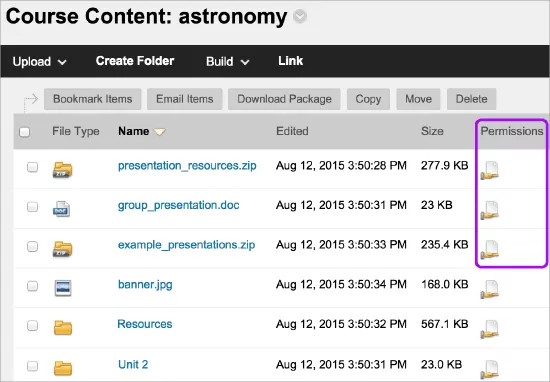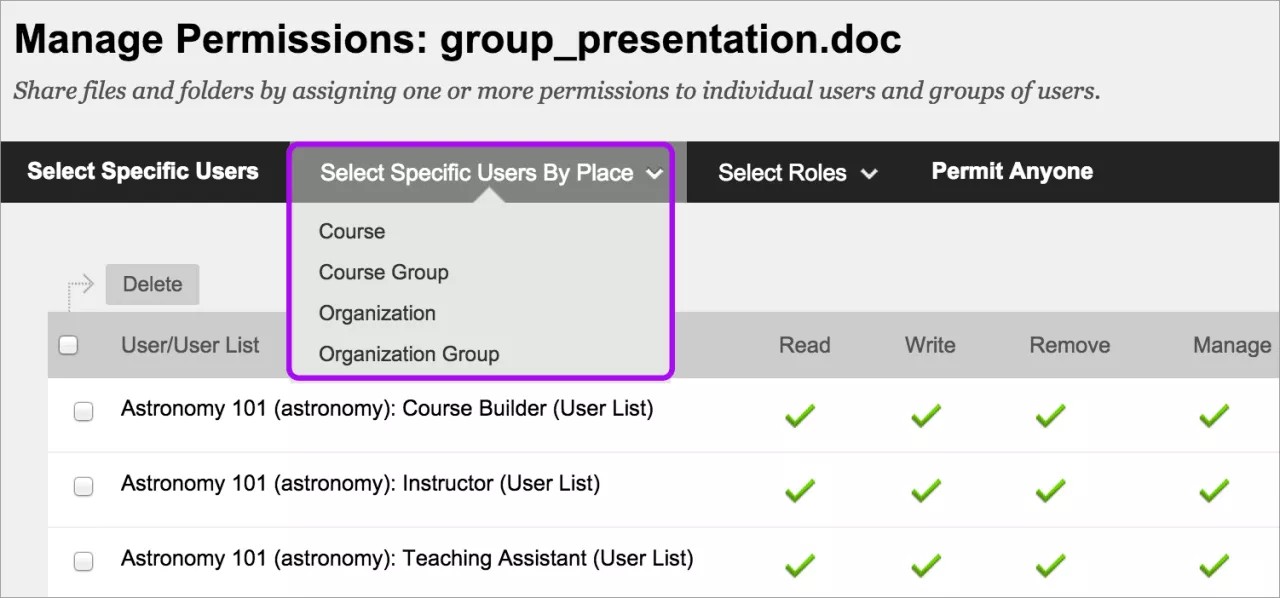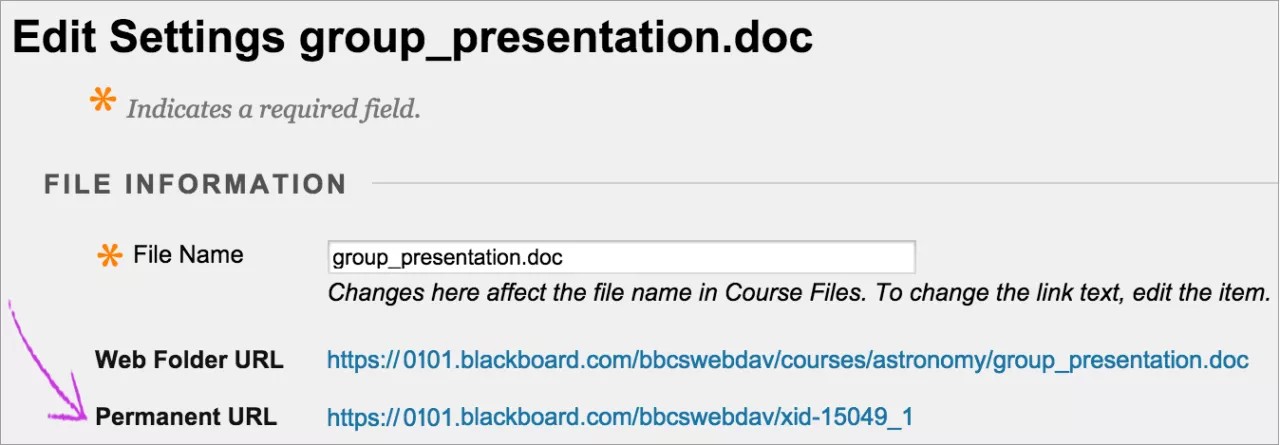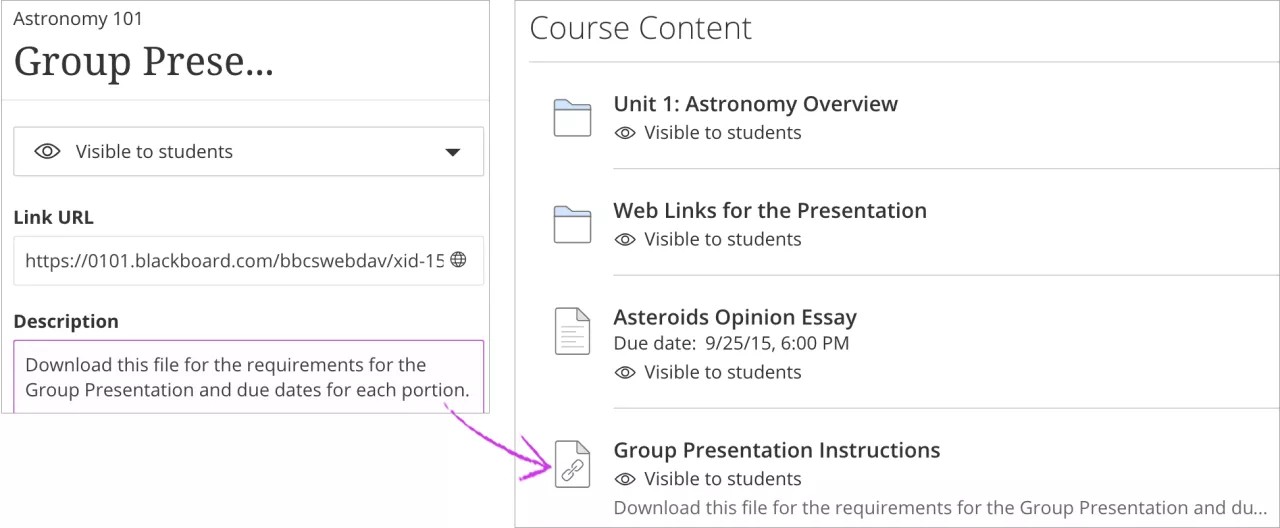The Content Collection is a file repository with several sophisticated features for working with content. The Content Collection provides repositories for Blackboard Learn courses and users, and is managed through the Administrator Panel. It also allows users to store, share, and publish content within personal user folders, course folders, and institution folders.
Most Content Collection features and settings in Blackboard Learn SaaS are identical to those of the Content Collection in Self- and Managed-Hosting deployments. We've noted any differences, including how the Ultra Course View interacts with the Content Collection, in the sections below. Visit full feature documentation about the Content Collection.
Use your browser's back button to return here when you're finished.
Learn more about how students use the Content Collection:
Learning more about how instructors use the Content Collection:
ULTRA: Content Collection
You can still use the Content Collection to organize, share, and reuse content.
In the list where your name appears, select the Tools link to access the Content Collection.
You'll see some changes to how you add permissions to content in your courses. You can also add files from the Content Collection directly to your Course Content page.
File and folder storage
With Ultra courses, you can access existing files for your courses from the Content Collection. Open the Course Content folder in the Content Collection menu and choose a course folder. You can create links to any of the files and folders in your course.
In Blackboard Learn with the Ultra experience, Content Collection items don't always have the same permissions that you added in the Original experience. For existing files and folders, permissions appear only for those roles that create content, such as Instructor, Course Builder, and Teaching Assistant.
For students to access files and folders that you link to in the Content Collection, you need to add Read permission to those items for the Student role. When you add Read permission to a folder, all the contents also receive Read permission. You want to be sure that any folder you share with students does not contain files or sub-folders you don't want them to see. When students select a link to a folder, they are taken out of the course to access the folder contents in the Content Collection.
You can add or remove permissions for other users as needed. For example, you can add the full set of permissions for another instructor on files and folders that you want to work on together. Or, you might want your teaching assistant to only have Read permission on a certain file.
You may find it helpful to move files to folders. Organize folders so that you can manage permissions by folder, rather than by file. For example, create a folder that contains all the files for a group project. You can share the folder with your students, rather than manage permissions on separate items stored in different folders.
If you want to share files with others in your institution or across courses, you can move or upload them in the Institution Content folder. You may not have the permissions required to move or upload files in the Institution Content folder. Contact your administrator to learn more.
Edit permissions on your files
Use these steps to add Read permission for students to files and folders in the Content Collection. Read permission allows students to access the items you link to in your course.
- Navigate to where the item is stored, such as the Course Content folder.
- Select the Permissions icon in the item's row.
- You can make changes to the existing permissions for the roles listed. Open a role's menu and select Edit or Delete.
- You can also add roles and permissions. For example, select Select Specific Users By Place to open the menu.
- Select Course to see the courses you have access to. Assign roles and permissions for that specific item. After you make your selections, select Submit.
- Use the breadcrumbs to navigate back to the course folder.
- Open the item's menu and select Edit Settings.
- On the Edit Settings page, copy the Permanent URL and select Cancel. Now you can create a link in your course that points to this item in the Content Collection.
Create a link to a file or folder
Use an item's Permanent URL to add a link in your course to a file or folder in the Content Collection.
- Navigate to the course where you want to add a link to the file or folder.
- On the Course Content page, select where you want the link to appear and select the plus sign.
- Select Create to open the Create Item panel and select Link.
- Type a title and optional description. Paste the URL that you copied from the Content Collection item and select Save.
- The new link appears on the Course Content page. Make the link visible to students when you are ready.
Edit and overwrite files
You can edit and overwrite individual files in the Content Collection while maintaining the links to those files in your courses.
For example, you can edit a file stored on your computer that is in the Content Collection and linked in your course. After you make edits, navigate to the file in the Content Collection so that you can add the edits. Open the item's menu and select Overwrite File to browse for the edited file on your computer. The system overwrites the existing file with the same name, even if the file on your computer has a different name. If the file is linked in your course, the link remains intact and the edits appear. No need to edit the link in your course. When you overwrite files in the Content Collection, file names and link titles in your course don't change. When students access the file in your course, they see the revised content.
Cloud Signed URL Settings
This setting only applies to Blackboard Learn SaaS environments.
Signed URLs allow content to be delivered directly and securely from cloud storage, which provides faster transfers and requires fewer resources to run on the system. A signed URL is equivalent to the actual file after it’s delivered to the browser.
Online content is essential in many mixed-mode and online courses, and poor performance can lead to a frustrating user experience. To help speed the delivery of online content, such as video and other multimedia, you can control content delivery through signed URLs.
Find the settings at Admin Panel > Content Management Settings > Cloud Storage Signed URL Settings.
| Setting | Description |
|---|---|
| URL Expiration Time | Set an expiration time between 180 minutes and 1440 minutes (24 hours). To guarantee a good user experience, this value must be greater than the minimum amount of time a user is expected to interact with a video, PDF, or other pieces of content. |
| Disabled MIME Types (Read-only settings) | Disable MIME types from being served directly from cloud storage. You can disable MIME types if your institution prefers or requires that certain file types aren't served via signed URLs. System performance may be impacted if you add multimedia file types (specifically movie or video file types) to this list. |
| Default Disabled MIME Types (Read-only settings) | Blackboard excludes certain MIME types by default. Blackboard can't deliver MIME types that may contain relative links via signed URLs. This limitation helps ensure links work as expected when embedded in HTML content. You can't edit this field. |
| Disabled User Agents (Read-only settings) | Specify user agents to disable for signed URLs. Blackboard excludes certain user agents by default because some WebDAV clients don't follow redirects properly. You can disable user agents if your institution prefers or requires that signed URLs aren't served on certain browsers, devices, or operating systems. |
| Approved User Agents (Read-only settings) | The user agents listed here are approved for signed URLs by default. You can't edit this field. |


